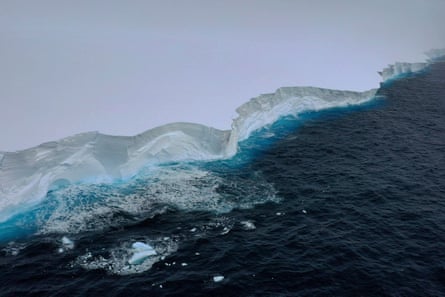Antarctic scientists have been able to get an “incredibly lucky” inspection of the world’s largest iceberg – about three times the size of New York City – which calved off the icy continent nearly 40 years ago.
The huge iceberg, known as A23a, was once attached to an ice shelf in West Antarctica, south of Chile, but separated in 1986. Since then, the iceberg has been stranded in the Weddell Sea, stuck to the ocean floor.
But last week, the British Antarctic Survey used satellite imagery to confirm the iceberg was no longer stuck and was drifting into an “iceberg alley” en route to the sub-Antarctic island of South Georgia.

British scientists on the icebreaking research vessel the RRS Sir David Attenborough have now been able to inspect the iceberg in person and release drone vision for the world to see. It measures about 4,000 sq km (1,500 square miles), which is more than twice the size of Greater London and nearly twice as large as the Australian Capital Territory.
The research vessel passed A23a while travelling south to investigate how Antarctic ecosystems are influencing the ocean’s carbon and nutrient cycles.
Dr Andrew Meijers, the chief scientist on the ship, said it was “incredibly lucky that the iceberg’s route out of the Weddell Sea sat directly across our planned path, and that we had the right team aboard to take advantage of this opportunity”.

“We’re fortunate that navigating A23a hasn’t had an impact on the tight timings for our science mission, and it is amazing to see this huge berg in person – it stretches as far as the eye can see,” Meijers, who is also the survey’s polar oceans science leader, said.
Laura Taylor, a biogeochemist, was part of the team of scientists who took samples of seawater around the iceberg. The survey hopes these samples will help determine how the iceberg is influencing the carbon levels in the water.

“We know that these giant icebergs can provide nutrients to the waters they pass through, creating thriving ecosystems in otherwise less productive areas,” Taylor said. “What we don’t know is what difference particular icebergs, their scale and their origins can make to that process.”
Ecosystems science leader of the team, Prof Geraint Tarling, said the calving of icebergs off ice shelves was “part of the natural life cycle of glaciers”.
“Polar ecosystems play a crucial role in regulating the balance of carbon and nutrients in the world’s oceans and are impacted by melting icebergs in numerous ways,” Tarling said.
“The data being collected will improve our understanding of these processes and their sensitivity to climate change.”





